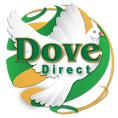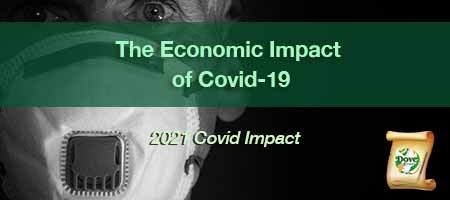The Economic Impact of Covid-19
Fiscal space: The capacity to support households and firms largely depends on access to international financial markets.
State Capacity: Fast and efficient implementation of policies to support households and firms requires a substantial state capacity and well-developed tax and transfer infrastructure.
Labor Market Structure: A large share of informal workers facing significant frictions to adopt remote working, and high levels of poverty and inequality, deepen the deleterious impact of the crisis.
That's a myriad of preexisting circumstances to deal with on a global scale.
Our Quote of the Day:
"If you set your goals ridiculously high and it's a failure, you will fail above everyone else's success."
—James Cameron
Impact Forecast
Economists predict that the global economy will most likely recover this year; however, the GDP level by the end of 2021, including advanced, emerging market, and developing economies (EMDE - Emerging and Developing Europe), remains below the pre-virus baseline per forecasts.
The IMF (2021) forecasts that in 2024 the World GDP will be 3 percent (6 percent for low-income countries, (LICs) below the no-Covid situation. This, of course, now includes the Delta Variant, which is rapidly spreading in the US. Lastly, the speed and recovery status will be the crucible that sways the width and breadth of the recovery, which exponentially reflects global governments' capacity to acquire and distribute the vaccines.
Losers and Winners
The Harvard Business Review states that "Fiscal stimulus was both enormous and necessary when the Covid crisis hit last year, and it successfully prevented the structural damage that weighs down recoveries. But even as the economy was on a better-than-expected rebound, the Biden administration and Congress opted for an additional stimulus package in the hope of delivering a booming economy that will boost workers' fortunes in the post-Covid economy. The downside to this stimulus bet is the risk of imbalances, such as inflation or asset bubbles, as the economy "overshoots."
There is no question that a remarkable recovery is afoot; however, businesses and leaders will face a political-economic question in the future. As wages are rising and workers are claiming an economic output continuing to grow, will business organizations' profit structure succumb under increased pressure?
- The Win-Win: This scenario suggests that wage gains will be paid for by business productivity growth. This idea puts forth the notion that businesses will not lose out from a higher wage standard as long as they realize productivity growth. Organizations should note that policymakers support this idea because there are no current or latent inflationary pressures as the economic potential expands and grows.
- The Win-Lose: This scenario views the workforce gains at the expense of businesses, which in effect would be reversing a longstanding trend. A win-lose suggests that in the event productivity growth lags behind wage growth in a controlled post-Covid world, organizations will need to deal with rising cost pressure. Insofar as businesses cannot pass these rising wage costs on to consumers, those margins will be contracted, and the workers' share of economic output would grow at companies' expense, thus eradicating a multi-decade trend.
- The Lose-Lose: The threat of inflation changes the cycle as policymakers will be dealing with a losing scenario. The Harvard Business Review states: "If wage pressures are not offset by productivity growth, and firms have the pricing power to pass them on to consumers, then inflation will result. If this occurs at a modest pace (say 2%), policymakers may be satisfied. But if it drives inflation sharply higher for some time, policymakers will have lost their stimulus bet. Faced with too much inflation, they would have to raise interest rates and risk a recession — a lose-lose all around. Such a 'policy error' occurs when the Fed has to move faster and stronger than anticipated to catch up with realized inflation. While an error, it remains the desirable course of action because ignoring emerging pressures has the potential to deliver far worse than a cyclical downturn."
What Can Your Business Do?
Businesses have always focused on productivity. However, due to the economic effects of the pandemic, productivity has reached center stage, in that growth, per se, is now critical moving the focus to produce more with existing inputs or produce the status quo with fewer inputs. It may sound easy peasy, but in reality, it's not. This scenario is particularly true while the pandemic continues to place an enormous strain on the workforce. However, multiple key levers can aid in sustainability. Again, from the experts of the Harvard Business Review:
- Seize the specific learnings from the crisis. Covid has forced many firms to survive and adapt to new realities, often by exploring new, digital, and often more efficient processes and channels.
- Institutionalize the learning process from the crisis. Covid also forced firms to try things they wouldn't have otherwise tried, often at surprisingly little cost. Now is the time to build processes that generate these learnings in more typical environments.
- Understand that the old playbook of plugging gaps by hiring the next worker will be complicated. Thus focus must shift to improving existing worker productivity through new technologies. In particular, the ongoing "digital transformation" of incumbent businesses has at worst the potential to increase the cost of doing business, and at best, could drive both growth and productivity. In this respect, the most significant gains will be reimagined business models that reflect the context of new needs and new possibilities rather than merely incrementally enhancements.
- Yet don't ignore existing technologies. Their use can often be deepened as previously, the tradeoff between incremental labor or capital investment was less favorable.
- And lead effectively. Leadership that gets everyone pushing in the same direction (ranging from the operational to the inspirational type) can unlock productivity gains.
The Net-Net
As we move through the next iteration of the Covid-19 variants, it is unclear how much the Delta variant will disrupt businesses, workers, healthcare, vaccines, or the economy. That said, productivity appears to be the critical metric that companies will need to tackle, particularly since it will be more challenging to hire new workers or replace workers. The inflation scenario could further exacerbate the challenges we are all facing. Focusing on productivity and leadership will best prepare organizations to weather the economic storm. Thanks for reading "The Economic Impact of Covid 19!"
Let us show you how to improve your document processes to optimize your workflow, reduce your costs, and maximize your organization's printing, letter shop, and mailing capabilities.
Dove Direct has an official USPS certified bureau located within our offices to save you time and money. We can even create a demo file for you. For more information, call Carla Eubanks at 404-629-0122 or email Carla at This email address is being protected from spambots. You need JavaScript enabled to view it..
Dove Direct, your Atlanta based print and mail solutions provider, offers organizations end-to-end data, printing, and mailing solutions:
- Data Management
- Variable Digital/Data Printing
- LetterShop and Fulfillment
- Digital Mail Scanning Services
- Fully Automated MLOCR Presort Bureau
- Marketing and Production Management Support
- Secure Data Life Cycle Management
If you don't want to wait, you can reach Dove Direct today by calling 404-629-0122 or use the Contact Form for Dove Direct.





